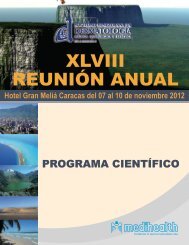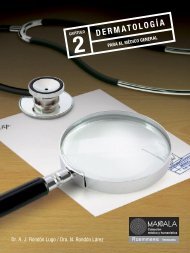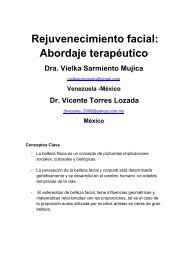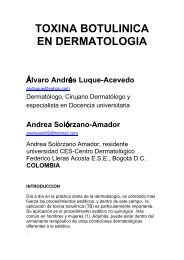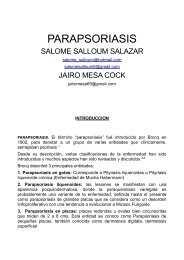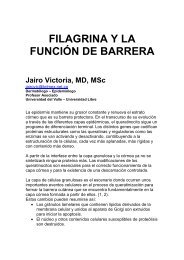Treatment of CIU DEFINITION OF CHRONIC URTICARIA - Antonio ...
Treatment of CIU DEFINITION OF CHRONIC URTICARIA - Antonio ...
Treatment of CIU DEFINITION OF CHRONIC URTICARIA - Antonio ...
- No tags were found...
Create successful ePaper yourself
Turn your PDF publications into a flip-book with our unique Google optimized e-Paper software.
Page 1<br />
<strong>Treatment</strong> <strong>of</strong> <strong>CIU</strong><br />
Lisa A. Beck, MD<br />
Associate Pr<strong>of</strong>essor <strong>of</strong> Dermatology and Medicine<br />
Johns Hopkins Asthma and Allergy Center<br />
Baltimore, MD<br />
<strong>DEFINITION</strong> <strong>OF</strong> <strong>CHRONIC</strong> <strong>URTICARIA</strong><br />
• Urticaria which persists for longer than 6 weeks in adults or<br />
12 weeks in children<br />
• 40 to 50% Chronic Autoimmune Urticaria (CAU)<br />
• 50 to 60% Chronic Idiopathic Urticaria (<strong>CIU</strong>)<br />
• A minority <strong>of</strong> cases can be characterized as physical<br />
urticarias: (heat, solar, light, cold, delayed pressure,<br />
dermatographism, , vibratory, aquagenic or cholinergic)
Page 2<br />
EPIDEMIOLOGY <strong>OF</strong> <strong>URTICARIA</strong><br />
• 20% <strong>of</strong> the population will be affected<br />
• identified in 0.1% <strong>of</strong> routine physicals<br />
• female / male = 2 / 1<br />
• all ages<br />
• 40% <strong>of</strong> pts with > 6 mos <strong>of</strong> <strong>CIU</strong> will still have<br />
urticaria 10 years later<br />
• Association with autoimmune thyroid diseases (12<br />
to 29% vs 6% for “normal” population) [Lezn<strong>of</strong>f 1983;<br />
Zauli 2001]<br />
ROUTINE HISTOLOGY<br />
Nondiagnostic:<br />
– Edema<br />
– Nonspecific mild perivascular infiltrate<br />
» 4 - fold increase in mononuclear cells (mostly CD4+ cells)<br />
» 10 - fold increase in mast cells<br />
» Th1 and Th2 mediated [Ying, 2002]<br />
» Increase in basophils<br />
PMN-rich<br />
Lymphocyte-rich
Page 3<br />
TREATMENT <strong>OF</strong> <strong>CIU</strong>/CAU<br />
• Antihistamines are the gold standard: nonsedating<br />
and sedating H1 antagonists.<br />
• Second line therapy: Leukotriene antagonists, H2<br />
antagonists, corticosteroids, cyclosporine (Gioacchino,<br />
2003)<br />
– Methotrexate (Gach 2001)<br />
– Hydroxychloroquin (Reeves 2004)<br />
– Dapsone (Fox 1988)<br />
– Cyclophosphamide (Bernstein 2002)<br />
– Plasmapheresis (Grattan, 1992)<br />
– Sulfasalazine (Fisher, 1989)<br />
– Anti-IgE (Zolair)<br />
– Anti-CD20 (Rituxan)<br />
SULFASALAZINE<br />
• Sulfapyridine covalently linked to 5-aminosalicylic acid.<br />
– Sulfa moiety: antimicrobial properties<br />
– Salicylate: anti-inflammatory agent<br />
• Used to treat RA, JRA, UC<br />
• Side effects: 33% headache, diarrhea, oligospermia (reversible). >10% gastric distress,<br />
photosensitivity,
Page 4<br />
ZOLAIR Rx FOR <strong>CHRONIC</strong><br />
<strong>URTICARIA</strong><br />
Mast Cell Effects<br />
Basophil Effects<br />
(Beck, 2004)<br />
TREATMENTS <strong>OF</strong> <strong>URTICARIA</strong><br />
(Second generation antihistamines)<br />
• Advise d/c <strong>of</strong> ASA, NSAIs and EtOH<br />
• Loratadine (Claritin): 5 to 10 mg qD in AM<br />
• Desloratadine (Clarinex):<br />
5 to 10 mg qD in AM<br />
• Cetirizine (Zyrtec):<br />
5 to 20 mg qD or in divided doses<br />
• Fex<strong>of</strong>enadine (Allegra):<br />
180 mg qD or 60 mg b.i.d.
Page 5<br />
TREATMENTS <strong>OF</strong> <strong>URTICARIA</strong><br />
(First generation antihistamines)<br />
• Hydroxyzine HCL (Atarax(<br />
or Vistaril):<br />
10 to 100 mg<br />
qD or 6 to 8hr PRN<br />
• Diphenhydramine (Benadryl): 12.5 to 100 mg per<br />
dose q 4 to 6 hr PRN<br />
• Cyproheptadine (Periactin):<br />
4 to 8 mg q 6hr PRN<br />
TREATMENTS <strong>OF</strong> <strong>URTICARIA</strong><br />
(H 2 blockers)<br />
• Zantac (Ranitidine): 150 mg B.I.D. or 300 mg qD<br />
• Tagamet (Cimetidine):<br />
400 mg B.I.D. or 800 mg qD<br />
• Pepcid (Famotidine):<br />
20 mg B.I.D. or 40 mg qD<br />
• Doxepin (Sinequan):<br />
–Adults: 25 to 100 mg qD up to max dose <strong>of</strong> 100<br />
mg qD<br />
–Children: 1 to 3 mg/kg/day
Page 6<br />
TREATMENT OPTIONS FOR PTS THAT FAIL<br />
OR ARE INTOLERANT <strong>OF</strong> ANTIHISTAMINES<br />
• Dapsone: 50 mg B.I.D.<br />
• Colchicine: 0.6 mg qD to T.I.D.<br />
LYMPHOCYTIC<br />
OR<br />
NEUTROPHILIC<br />
NEUTROPHILIC<br />
<strong>CIU</strong><br />
ONLY<br />
• Sulfasalazine: 500 mg qD ⇒ 2 gms B.I.D.<br />
• Hydroxychloroquine: 200mg B.I.D. (Adults)<br />
TREATMENT OPTIONS FOR<br />
AUTO-IMMUNE <strong>URTICARIA</strong><br />
• Cyclosporin A: 3-5 mg/kg/day - only Rx for which there is<br />
a DBPC trial.<br />
• IVIG: 0.4 mg/kg/day x 5 days<br />
• Thyroid replacement if hypothyroid
Page 7<br />
APPROACH TO STEROID DOSING<br />
IN PTS WITH SEVERE <strong>URTICARIA</strong><br />
1. Start alternate day therapy<br />
! e.g. 20 mg prednisone q.o.d.<br />
2. Daily steroids, taper to every other day<br />
! e.g. 50, 50, 50, 45, 40, 35, 30, 25, 20, 15, 20, 10, 20, 5, 20, 0<br />
3. For uncommon severe angioedema<br />
! 50 to 60 mg prednisone in single dose<br />
! 40 mg next day if swelling persists<br />
! Discontinue without tapering or return to prior every other<br />
day dosage<br />
(from Kaplan A., Can. J. Allergy & Clin. Immunol. 1999)


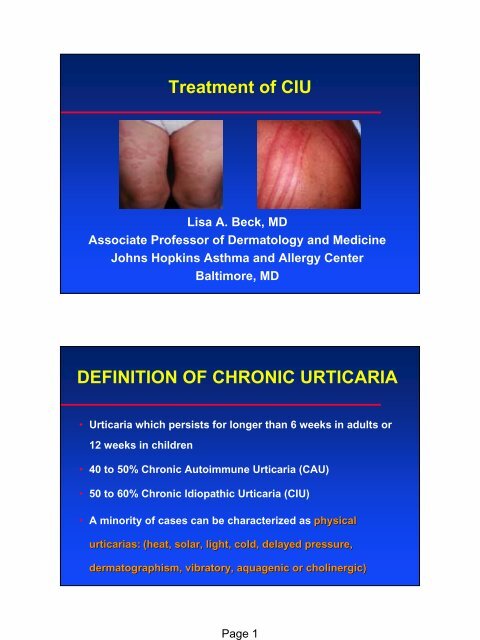
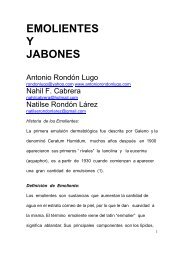
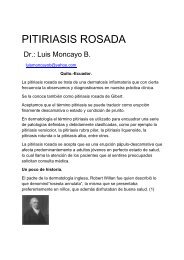
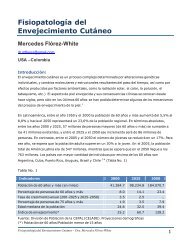
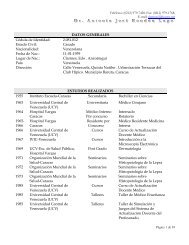
![ESTEROIDES atd [Modo de compatibilidad] - Antonio Rondón Lugo](https://img.yumpu.com/48821034/1/190x134/esteroides-atd-modo-de-compatibilidad-antonio-rondan-lugo.jpg?quality=85)
